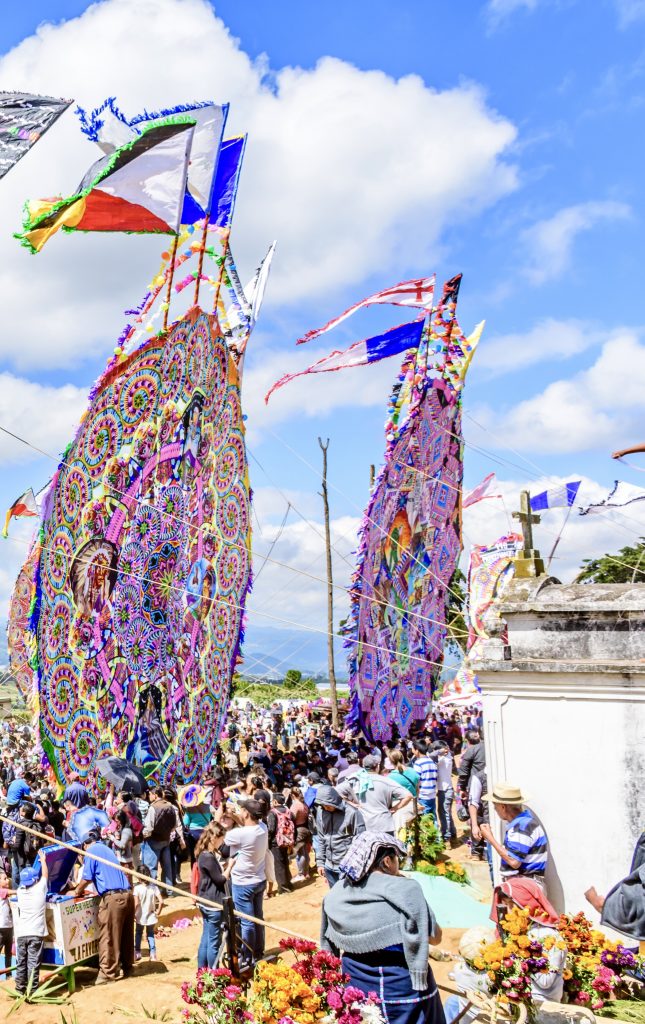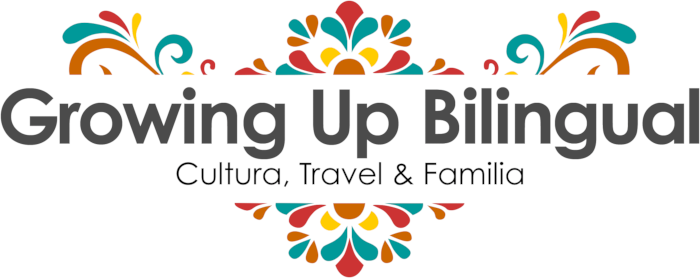Guatemalan traditional dances are a vibrant expression of the country’s rich cultural heritage, blending ancient rituals with colorful storytelling. Here you will find the most popular danzas folcloricas or folk dances in Guatemala. I will be sharing each dance’s significance in Guatemalan traditions, it’s history as well as the when and where you can see each of these dances from el baile del Venado and La Conquista to the popular baile de Moros y Cristianos, the Palo Volador, the Rabinal Achí and many more.
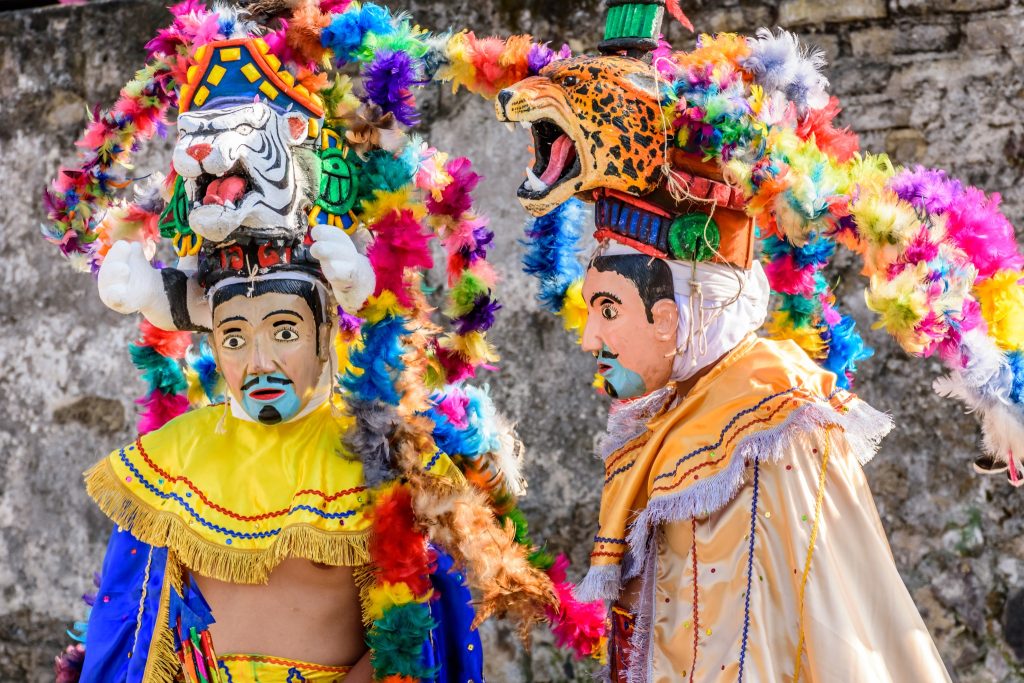
The Origin of Guatemalan Folk Dances
Guatemalan traditions blend of Maya and Spanish cultures that resulting in a mixed heritage, reflected in daily life across the country. This cultural fusion is also evident in the traditional dances performed throughout Guatemala. The original pre-Hispanic dances, although banned by the Spanish, survived albeit modified by historical events and beliefs from the Iberian Peninsula. The intent was to eradicate these dances entirely, but many structures from the 16th century, like the dancers’ formations, movements, and characters, persisted. Pre-Hispanic dances also included vocal sounds mimicking birds or small mammals.
The Spirituality of Guatemalan Traditional Dances or Danzas
Traditional dance, distinct from casual dancing, is ritualistic and performed at sacred times and places. Some dances have been preserved for centuries and are performed during patron saint festivals, church atriums, and processions, serving as a communion with ancestors and a reaffirmation of beliefs. These dances involve reciting anonymous colonial-era texts, accompanied by music from various traditional instruments.
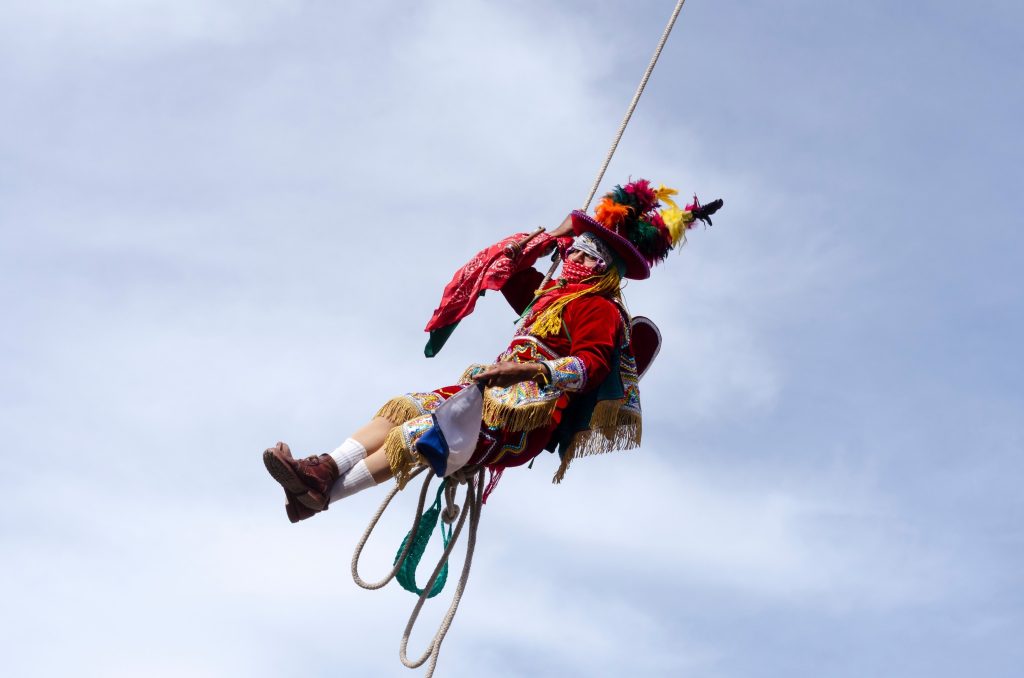
Traditional dances are a highlight during patron saint festivals or fiestas patronales in various cities and towns across Guatemala. Dancers participate out of devotion, aiming to dance for at least seven consecutive years, bearing all their expenses. Being part of a dance group is considered a privilege and blessing.

Each dance has its spiritual guides responsible for rituals related to natural forces and spirits, known as diviners or spiritual leaders. They bless the costumes, musical instruments, masks, altars, flowers, candles, ritual food and drinks, and the dancers themselves, ensuring the preservation of this rich cultural heritage.
These dances foster family cohesion and community solidarity, with family members supporting the dancers by providing food, drinks, and assistance with costumes and masks.
The Most Popular Folk Dances in Guatemala
Las danzas folclóricas or folk dances in Guatemala, often colorful and vibrant, tell stories of the past and present, blending indigenous, European, and African influences. From the famous “Baile de la Conquista” (Dance of the Conquest), which portrays historical battles, to the lively “Baile del Venado” (Dance of the Deer) or the exciting “Palo Volador”, each dance offers a unique glimpse into Guatemalan life and traditions. This section of the article will explore some of the most beloved folk dances in Guatemala, showcasing their significance and beauty.
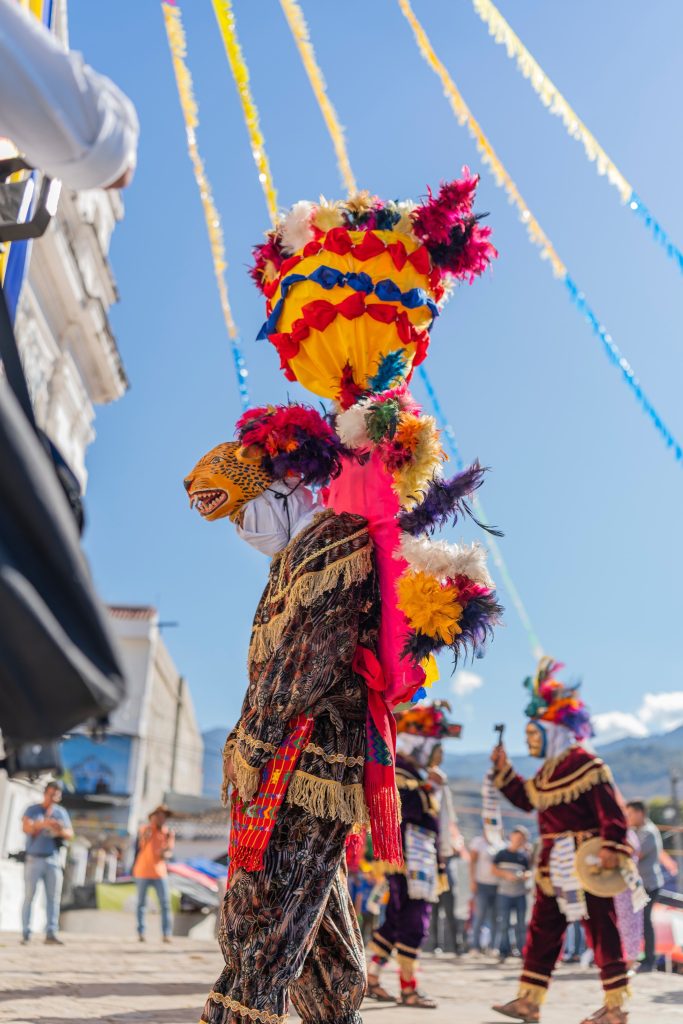
Baile del los Toritos
The “Danza de Toritos” or “Dance of the Little Bulls” is a unique representation of a 17th-century bullfight, traditionally organized to honor a town’s patron saint. This tradition began when the Spanish introduced cattle to the Americas, captivating the native inhabitants with the novelty of bullfighting. Unlike traditional bullfights ending in the bull’s sacrifice, this dance intriguingly depicts the goring and subsequent miraculous resurrection of the patron or steward at the saint’s altar, after pleas and prayers. This aspect of the dance reflects the indigenous people’s use of the art form to criticize and mock the Spanish bullfighting practices.
The dance features a series of musical pieces, each corresponding to a specific scene in the narrative. These scenes include the gathering, steward, blacks, chained, bulls, cowboys, and the bullfight, with dancers performing in pairs. The dance has a strong traditional component, with marimba music forming the backbone of the performance, and recently, saxophones have been added to the ensemble. This dance is not only a display of culture but also a lengthy affair, sometimes involving over 30 participants and extending beyond three hours.
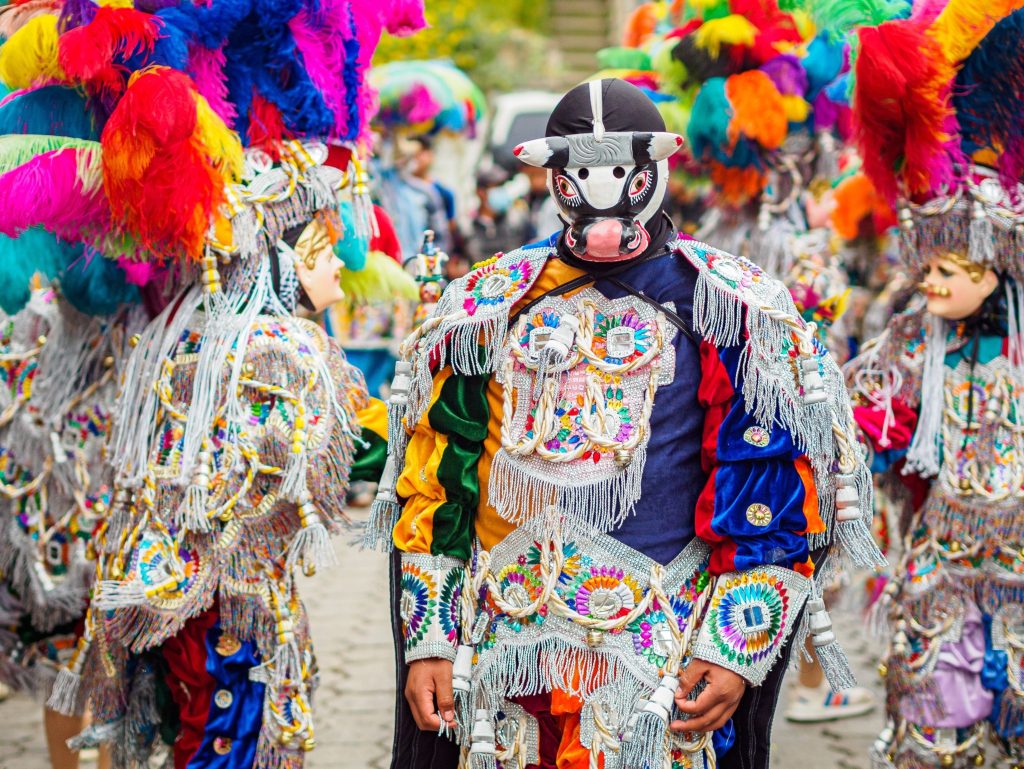
“Danza de Toritos” is not just a dance but a cultural expression that varies across different Guatemalan communities. Each area, particularly in the Maya K’iche’, Mam, and Kaqchikel regions, adds its unique twist to the dance, reflecting local customs and histories. These variations can include different characters like Kaxuxa in Patzún, Chimaltenango, representing the daughters of the hacienda owner. This dance, hence, serves as a living tapestry of Guatemala’s rich and diverse cultural heritage, performed in various regions and carrying the essence of local traditions and stories.
Danza de los Moros y Cristianos
The “Baile de los Mmoros y Crisianos” ( Dance of Moors and Christians) is a traditional performance in Mesoamerica and the Caribbean, with its origins tracing back to the 6th century. It was inspired by Spanish stories of chivalry and military battles called “romanceros españoles.” These stories detail the Reconquista, a period when Spanish territories were reclaimed from Arab rule from 710 A.D. to the fall of the Emirate of Granada in 1492. This dance mainly focuses on celebrating the Christian faith’s victory over Muslim and Judeo-Hebraic beliefs.
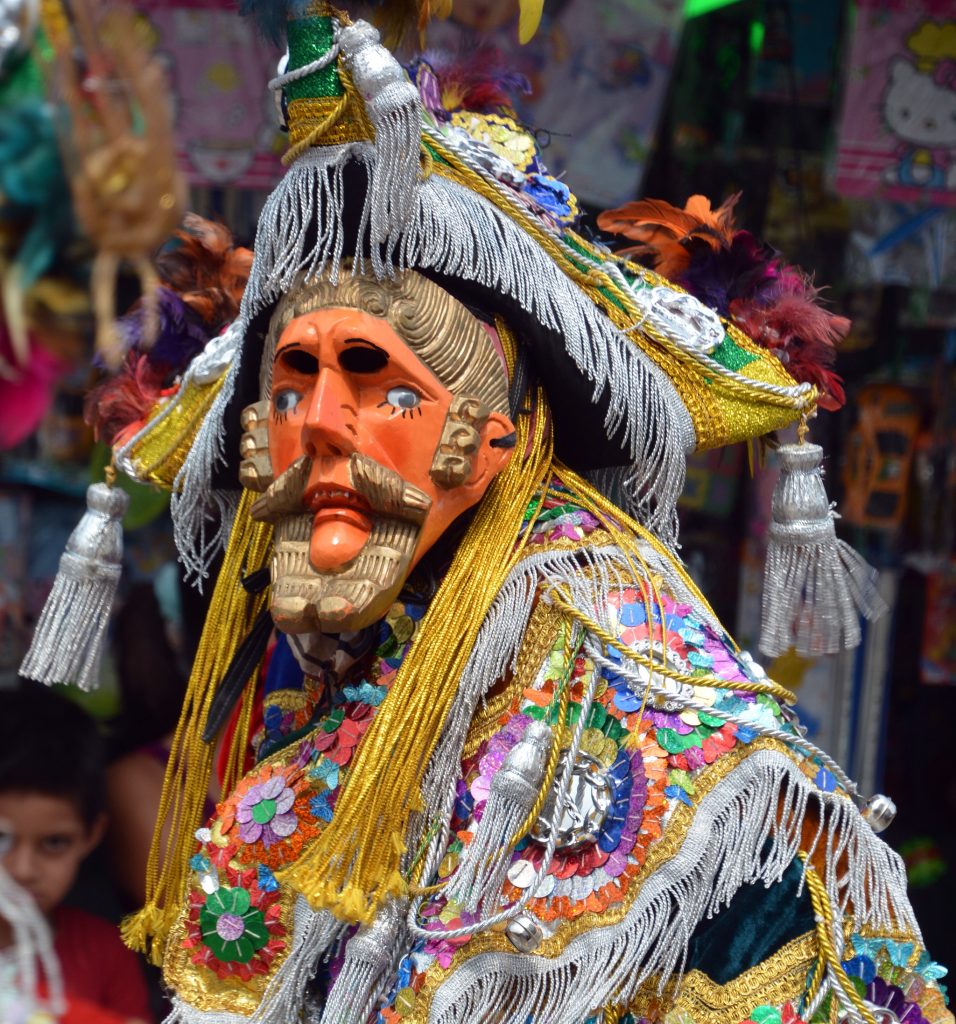
Historically significant, this dance was mentioned by Domingo Juarros in 1680 during the inauguration of the Cathedral of Santiago de los Caballeros de Guatemala. He observed performances by groups representing indigenous people, Turks, Spaniards, and Moors, showing its role in the cultural narrative of the time.
The Dance of Moors and Christians is more than just a performance; it reflects the historical perspective of Spanish conquerors in America, who considered themselves victorious over Arabs and eager to establish their religion while dominating the indigenous people. Stories of legendary heroes like Charlemagne, the Cid Campeador, Ferdinand of Aragon, and Saint James the Conqueror were used in evangelization to promote Christianity. Over the years, the dance has evolved, incorporating various historical inaccuracies and myths. Its central theme remains a critique of Arab and Muslim actions during invasions and a celebration of Christianity’s triumph. The dance creatively combines historical figures like Charlemagne with Napoleon or the Moorish king Cosem and Hernán Cortez, blending history and myth in a unique cultural expression.
Danza de los Gigantes
The “Baile del los Gigantes” (Dance of Giants), which came from Europe, has been a part of Guatemala since the 18th century. It showcases four large figures that look like people, with two having pink faces and the other two black. Each figure is about three meters tall. Inside, a person controls a wooden structure that helps the figure move and “dance” in time with marimba music. This dance is especially seen in areas like Chimaltenango, Sacatepéquez, Guatemala, and Sololá, where the Kaqchikel ethnic group lives. Each place adds its own touch to the dance.
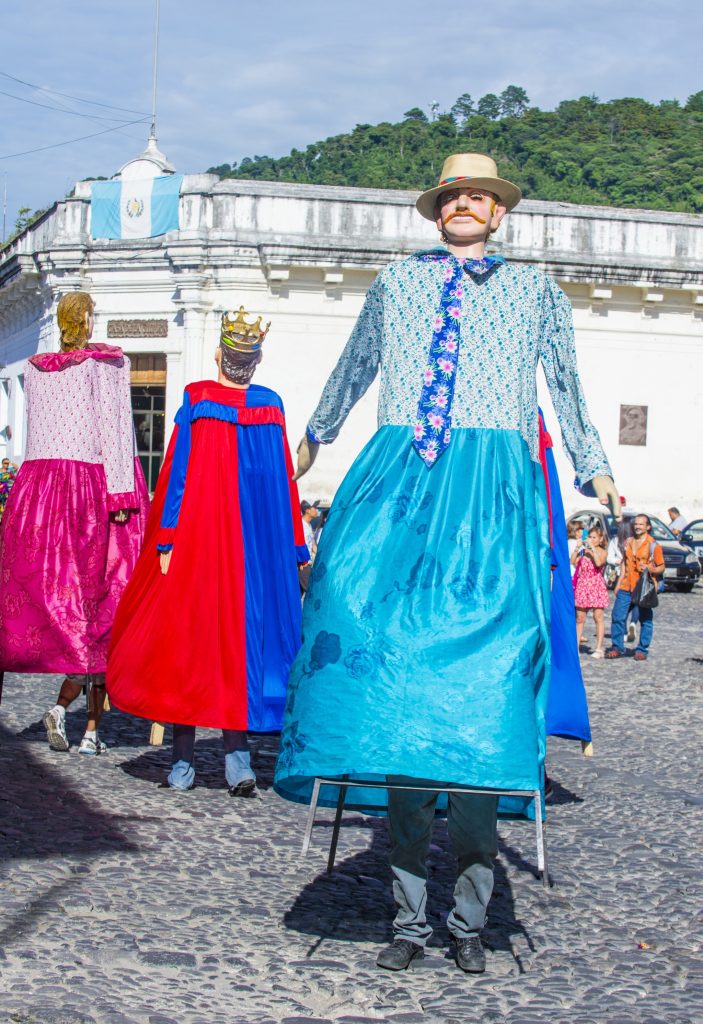
This dance connects to ancient stories from the Popol Vuh, a sacred K’iche’ text. It tells about giants who were around before humans. Characters like Zipacná, who played with mountains as if they were balls, and Cabracán, who shook mountains with his strength, were notable for their size and power. These giants were defeated by the heroic twins Hunahpú and Xbalanqué for misusing their abilities. In the 1930s, an American researcher found a version of this dance that echoed the Popol Vuh, but it’s not seen anymore.
To bring these giant figures to life, a person steps inside a frame made of long wooden poles. The heads are usually made from wood or fiberglass. The frame has parts for the dancer to hold and rest on while carrying the structure. Nowadays, some frames are metal, making them lighter and easier to move. The front of each giant’s costume has a hole so the dancer can see and walk around. These changes have made the dance easier to perform and more enjoyable to watch.
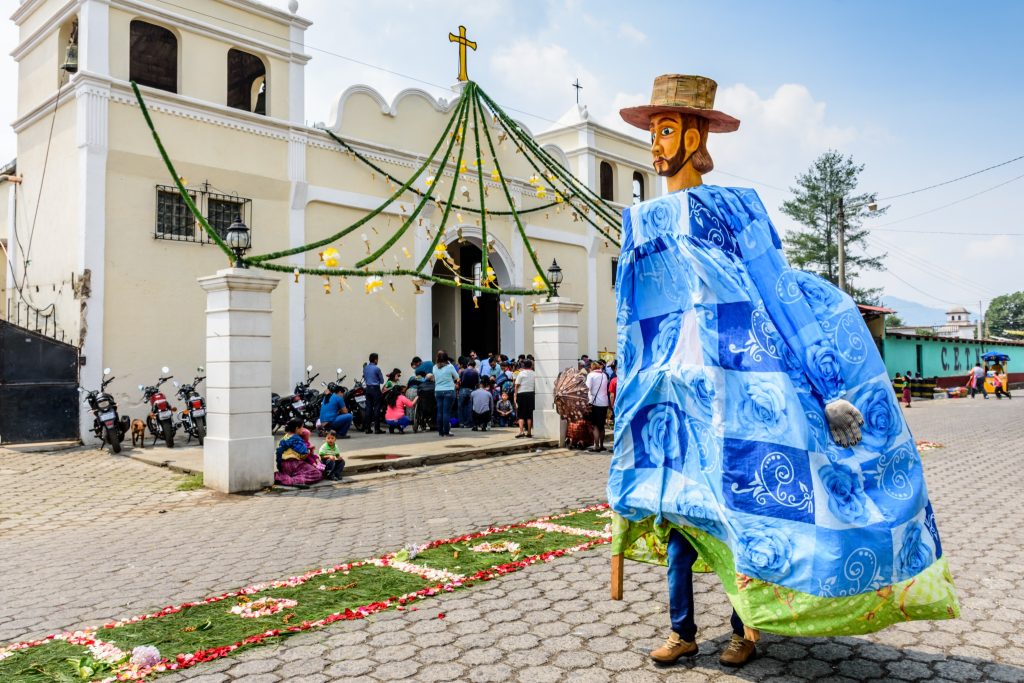
Baile de las Guacamayas
The Baile de las Guacamayas (Dance of the Macaws) or The Dance of Ma’ Muun, originating from Santa Cruz Verapaz in Guatemala, is a traditional dance with roots in pre-Hispanic times. It shares similarities with the Rabinal Achí or Baile del Tun, a dance from Rabinal, Baja Verapaz. Both dances involve storytelling, unique pre-dance rituals, and a similar style of dancing. The central theme of both dances is the abduction of a maiden. The story of Ma’ Muun revolves around his daughter Waxaq, who is either willingly eloped or forcibly taken by Kiché Winak, depending on the version of the tale. Another interpretation from the Q’ekchi’ culture narrates the story of a maiden and a hunter, symbolically transforming into the Sun and Moon, representing their eternal love.
View this post on Instagram
In the tale, Ma’Muun, an elderly chief, and his wife Ate’t Muun return from hunting to find their daughter missing. They search desperately for her. Meanwhile, Kiché Winak plans to present Waxaq to his parents as his wife but decides to discuss it with her parents first. Ma’Muun calls upon the god Ajaw for assistance. Two warrior spirits, transformed into macaws, find the couple in Rabinal. Ma’Muun challenges Kiché Winak to battle. During the dance, the macaws hold a red sash, symbolizing the battlefield’s boundary. After a fierce duel, Ma’ Muun defeats Kiché Winak. The victorious Ma’Muun sacrifices Kiché Winak, with the macaw warriors joining in the ritual.
View this post on Instagram
The dance is characterized by nine circular movements in a counterclockwise direction, known as salutes. The macaw warriors move back and forth parallel to the group. The performance lasts over an hour, with dance steps resembling those in the Rabinal Achí drama. The dance not only entertains but also serves as a reminder of the region’s rich cultural history and the deep-rooted traditions passed down through generations.
Danza de la Conquista
The “Baile de la Conquista” (Dance of the Conquest) is a traditional dance from Spain, performed since the mid-16th century in Mexico, El Salvador, and Guatemala. It portrays the battle between the K’iche’ army, led by Tecún Umán, and the Spanish forces under Pedro de Alvarado, leading to the Christian conversion of King Kikab and his warriors. Originating from the Moros y Cristianos dance, which celebrates Spain’s Reconquista from the Arabs, the Dance of the Conquest adapted these themes to the context of the New World, emphasizing the dominance of the Catholic Church and the Spanish crown.
First seen around 1680, the dance draws from a variety of sources, including the Danza del Volcán, which depicted a battle between the Kaqchikel Maya and the Spanish. Scripts for the dance were written by Spanish friars, but indigenous manuscripts also record these historic battles. The dance features 20 characters, representing both the indigenous and Spanish sides, including Tecún Umán and Pedro de Alvarado. The indigenous group is portrayed by characters such as Tecún Umán, and the Spanish side includes figures like Pedro de Alvarado, showcasing the cultural and historical blend of the dance.
The Dance of the Conquest is more than a mere performance; it’s a homage to the sacrifice of Tecún Umán, who died defending his people’s identity. This dance symbolizes the fusion of pre-Hispanic spiritual traditions with European influences, remaining a vital part of Guatemalan culture. It serves as a means to honor ancestors and maintain a connection with the nation’s rich and diverse historical roots.
Danza de los 24 Diablos
The Baile de los 24 Diablos (Dance of the 24 Devils) is a traditional European dance that dates back to the 13th century, celebrated especially during Corpus Christi and the Immaculate Conception. This dance made its way to Guatemala in the 16th century. The earliest known scripts of this dance-drama come from Cobán in the late 19th century and from Chichicastenango in 1946. The dance was formally established in the mid-19th century, with its original script, music, and steps developed at that time.
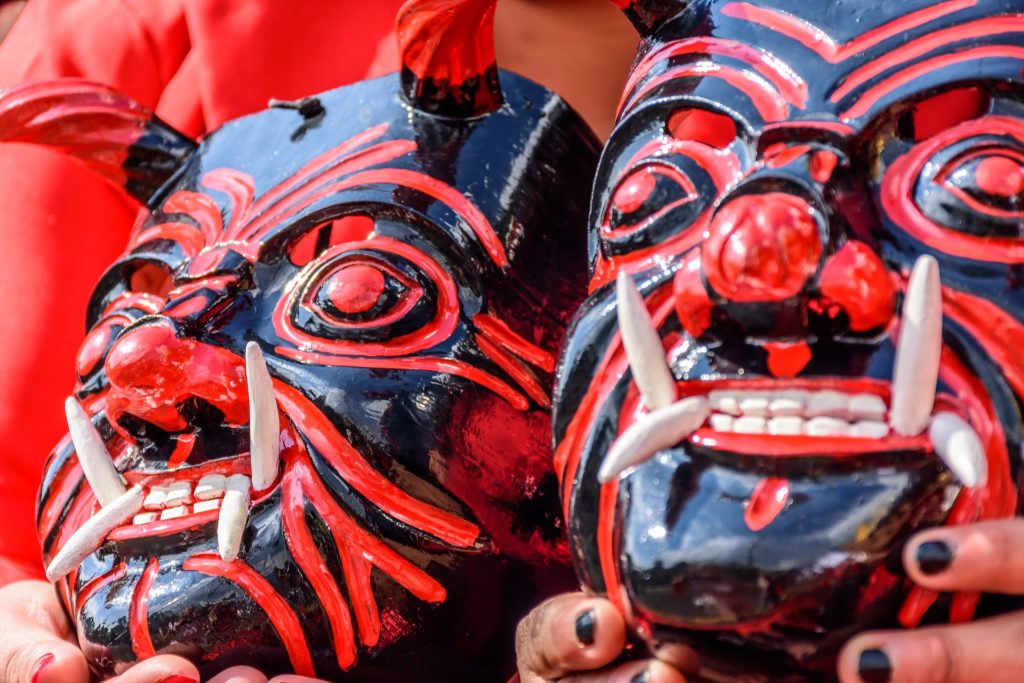
In the dance, the devils represent the seven deadly sins and other vices like alcoholism, bringing to life the age-old battle between virtue and vice. The performance includes 23 adults and a child representing the Archangel Michael. These characters are split into two lines, each embodying different roles, such as the lead devil, the greedy one, the drunkard, death, the soul, and other symbolic figures. They dance in pairs, each devil reciting verses and engaging in a symbolic struggle to win souls for hell, while the Archangel Michael and Death watch over the scene, representing protection and the inevitability of fate.
The Dance of the 24 Devils is not just a performance but a vivid portrayal of the eternal conflict between good and evil. The devils, adorned with masks and carrying various percussion instruments, create a rhythmic, lively atmosphere, with each character playing a distinct role in the narrative. The music, a repetitive sonata unique to each character, is played by an accordionist and a guitarist, enhancing the dramatic effect. This dance, with its rich symbolism and historical roots, continues to be a significant part of Guatemala’s cultural heritage, illustrating the nation’s deep connection with its European and spiritual past.
Danza de Monos y Venados
The “Baile de los Monos y Venados” (Dance of Monkeys and Deer) is a unique celebration held in San Andrés Xecul, Totonicapán, on November 30th. This date marks the martyrdom of Saint Andrew, the area’s patron saint. In this dance, the Mayan languages of Ba’tz’, k’oy, and ma’ax reference the howler monkey (zaraguate) and the spider monkey, both important in ancient Maya culture.
The sacred Maya book, Popol Vuh, tells the story of Hunbatz and Hunchouén, sons of the Maize God, who were transformed into monkeys as a consequence of their envy and disrespect towards community norms and their younger siblings. This transformation is reflected in the dance which features six monkeys, two or more deer, jaguars, dogs, a hunter, and his wife. The dance is an all-male performance, with women supporting in other roles.

A key feature of this dance is a large pine or cypress pole, about 24 meters tall and 1.5 meters wide. The performers climb this pole using ladders to perform acrobatics and slide along a rope to the temple’s facade. As part of the ritual, dancers carry small whips, believed to have purifying powers for themselves and others.
Danza del Venado
The “Baile del Venado” or Dance of the Deer is a traditional Guatemalan dance with roots going back to the time when the ancient Maya hunted deer, around 300-900 AD. This dance is closely tied to mythology and ancient stories. According to the Popol Vuh, a sacred Maya text, the deer symbolizes Tohil, the war deity. The dance portrays the conflict between hunters and other wild animals fighting over the deer meat, making it a significant hunting dance in Guatemala.
View this post on Instagram
Another story from Alta Verapaz tells of deer climbing the Xucaneb hill to ask the god Tzuul-ta ka for rain, while in the Kiché version, they plea to the God Mundo. The dance has evolved over time, with the Catholic religion adding elements of worship to Jesus. A notable variation of this dance occurs in Santa Cruz Balam’ Ya, Chimaltenango, during the patron saint festivals and Corpus Christi. This version includes a story about a golden cross and consecrated host appearing in a nearby river, which were brought to the church’s altar only after getting the approval from the spirits of the jaguar and deer living in the mountains.
View this post on Instagram
Rabinal Achi
The Rabinal Achi is the only pre-Hispanic theater-drama preserved in the Americas and recounts events from 800 years ago in the Baja Verapaz department’s Zamaneb or Urram valley. In the Achi language, this dance is known as Xajoj Tun, meaning “dance of the tun” in Spanish. The drama revolves around the conflict between princes Rabinal Achí and Kiché Achí, with Kiché Achí being judged and sentenced to death, but allowed to say farewell and partake in royal rituals due to his noble status.
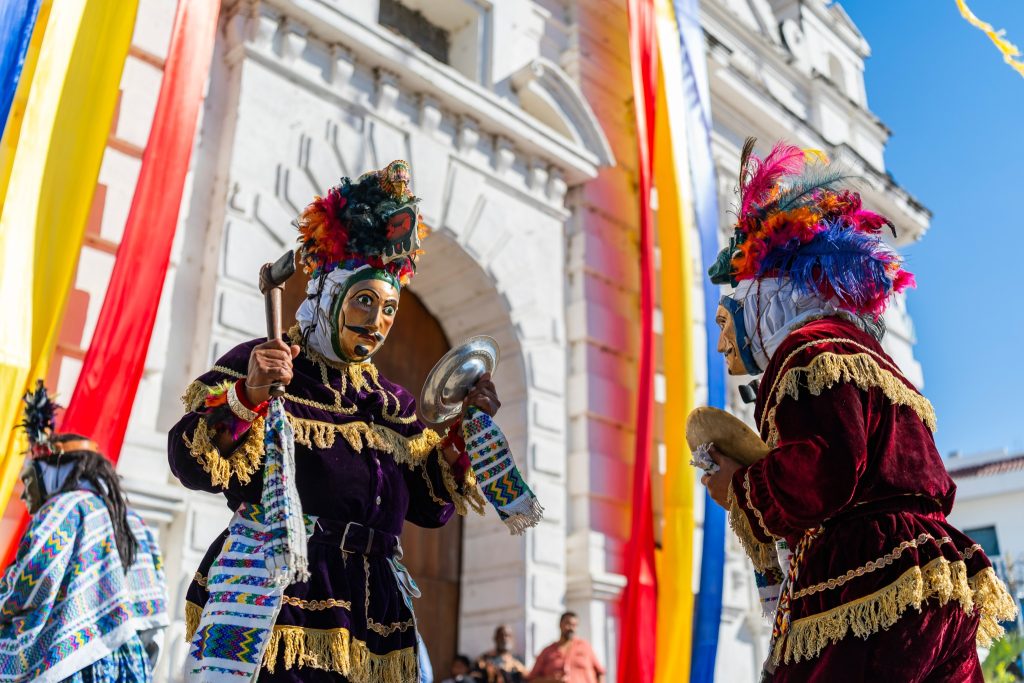
The Xajoj Tun was secretly practiced from 1625 until 1856 when it was translated into French by a priest. This translation was based on the narration by a senior indigenous comrade, member of a cofradía or religious brotherhood, who orally learned it from his ancestors. The music, distinct from Western styles, comprises ancient and archaic melodic and rhythmic structures. Metal trumpets have replaced pre-Hispanic wooden ones, and players perform with precision and control, synchronizing the melody and rhythm.
The play, characterized by its solemnity, portrays the trial of the Kiché warrior by Rabinal Achí and his father, Ajaw Job Toj. Set in the ancient pre-Hispanic capitals Kajyub (Rabinal royalty) and Utatlán (Kiché kingdom), it unfolds in four acts. The narrative includes accusations of deception, discussions of past confrontations, and a portrayal of the Kiché baron’s defiance and eventual identification.

In the second act, the Kiché warrior rejects compromises and maintains a hostile demeanor. The final act sees his stubborn refusal of offers, leading to his death sentence, though he’s granted final rites. This tale occurs both outside and inside the citadel residence of King Job Toj, today revered as an archaeological site in Rabinal.
Where to see The Rabinal Achí Dance in Guatemala?
The Rabinal Achí is a traditional Mayan dance-drama that is an integral part of Guatemala’s cultural heritage. This captivating performance can be witnessed in the town of Rabinal, located in the Baja Verapaz department. The dance is typically performed during the annual Rabinal festival, which takes place from January 19th to 25th, coinciding with the feast day of Saint Paul. The highlight of the festival is the enactment of the Rabinal Achí, which occurs on January 25th.
To experience the Rabinal Achí, you will need to travel to Rabinal. From Guatemala City, it is approximately a 4-5 hour drive (around 180 kilometers) via CA-9 and CA-5. Public buses and shuttles are available from the capital to Rabinal, making the journey accessible and convenient. Once in Rabinal, you can immerse yourself in the vibrant festivities, which include traditional dances, music, and the much-anticipated performance of the Rabinal Achí. Arriving a few days before the 25th will give you the opportunity to explore the town and enjoy the buildup to this cultural highlight.
El Palo Volador
The “Palo Volador” dance is based on the ancient legends found in the Popol Vuh, a sacred text of the K’iche’ Maya. It tells the story of Hunahpú and Ixbalanqué, two young heroes who transformed their mischievous older brothers, Humbatz and Hunchouén, into monkeys. The transformation caused their grandmother great sadness, and she pleaded for the boys to be restored to their human form. Hunahpú and Ixbalanqué, playing a haunting melody on their flutes, urged their grandmother to hold back her laughter when the monkey-brothers danced. Despite her efforts, she laughed, leading the transformed princes to disappear, never to show their faces again.
View this post on Instagram
This dance also connects to another tale from the Popol Vuh about the tragic fate of 400 young warriors slain by Zipacná, the mountain-maker. While the story doesn’t directly reference the pole used in the dance, it’s been mentioned in various historical accounts, suggesting its deep roots in tradition. In the dance, eight performers, referred to as monkey flyers, ascend a pole, symbolizing the narrative’s characters. The Catholic influence added another layer, introducing divine messengers like “San Migueles” or “archangels,” blending indigenous beliefs with Christian elements.
View this post on Instagram
Where to see Baile del Palo Volador or Flying Pole Dance in Guatemala?
The Flying pole Dance in Guatemala is celebrated in following places:
Cubulco, Baja Verapaz:
- Dates:
- How to get there: Cubulco is located in the Baja Verapaz department, located at 15°6′30″N 90°37′50″W the easiest, fastest and safest ways to get there is to rent a car or hire a private driver. For a more affordable option you can take a bus from Guatemala City.
- Where to stay: There are very few options for accommodations in Cubulco these include. Another option is to stay in the nearby town of Rabinal about 30min from Cubulco. Some hotel options here include Hotel Sesam and Hotel Posada San Pablo (WhatsApp +502 . Note: these small town hotels are usually rustic two star hotels and can only be booked directly by phone. My recommendation is to get the WhatsApp app and make sure you understand Spanish or have a good translator.
Chichicasatenango:
- Dates:
- How to get there: because Chichicastenengo is a popular tourist destination there are shuttles from Antigua. Guatemala City and Atitlán as well as day tours.
- Where to stay: Unlique Cubulco, Joyabaj and Santa Clara la Laguna, Chichicastenengo is a popular tourist spot which means there is better hotels and you have a higher probability to find people who understand English here. My recommendations for the best hotels in Chichicastenengo include:
Joyabaj
Santa Clara La Laguna, Sololá:
Los Convites
Convites in Guatemala are lively parades that have evolved from European mojigangas, known for their whimsical and carnival-like nature. These unique processions, rooted in medieval Europe, made their way to Guatemala during colonial times. In these parades, people dress up in creative costumes, often portraying animals like monkeys, tigers, and deer, or embodying mysterious and extravagant characters. Since the 1960s, with the influence of television and cinema, the convites have embraced modern pop culture, with participants donning costumes of popular media characters and celebrities, adding a contemporary twist to the tradition. The rule is to never repeat a costume, ensuring a fresh and exciting experience every year.
Adding a personal touch to this already vibrant celebration, Custom Patches can complement the creative costumes of convites. Whether featuring traditional Guatemalan symbols like the Quetzal bird or elements inspired by modern pop culture, patches can enhance the visual spectacle while allowing participants to showcase their individuality. From intricate embroidery to bold designs, these small but meaningful details contribute to the rich tapestry of the parade, making each costume even more unique as the convites fill the streets with color and energy.
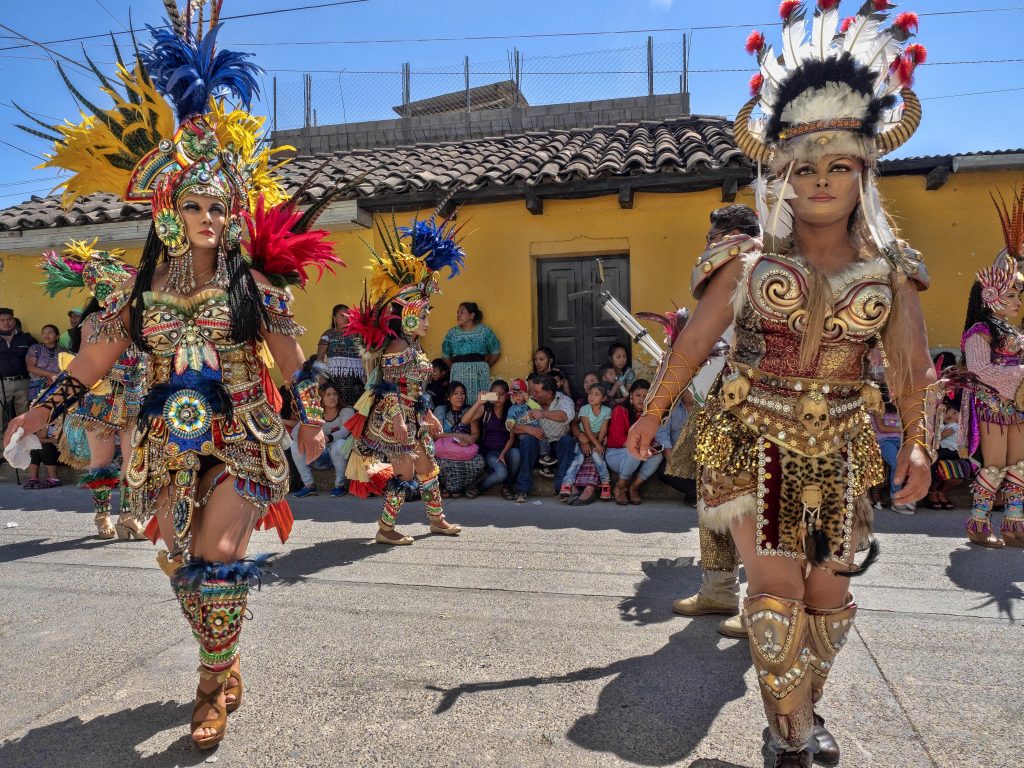
The essence of Guatemalan convites is their festive and carefree spirit. Participants, adorned in their vibrant costumes and masks, dance through the town streets to a mix of traditional and modern music. They make special stops at houses of community members who have previously invited them, where they perform dance routines for several songs. These performances are not just entertaining but also create a bond within the community. After dancing in the streets, the participants are welcomed into homes for a feast of food and drinks, deepening the sense of community and celebration. This direct community involvement is what makes convites a cherished and joyous tradition in Guatemala, fostering a sense of unity and fun.
Where to see Los Convites Dance in Guatemala?
Other Articles About Guatemalan Culture and Traditions
Semana Santa In Guatemala: Traditions And History
Semana Santa, also known as Holy Week, holds great importance and is widely celebrated in Guatemala. This week-long event is a time for religious contemplation and also an opportunity to display the country’s vibrant cultural heritage. Semana Santa has been observed for centuries. These Guatemalan Easter traditions are deeply rooted in the social fabric of Guatemala. Learn about the cultural significance of Semana Santa in Guatemala, about it’s the famous sawdust carpets and the significance and main elements of the processions in Antigua Guatemala and the rest of the country.
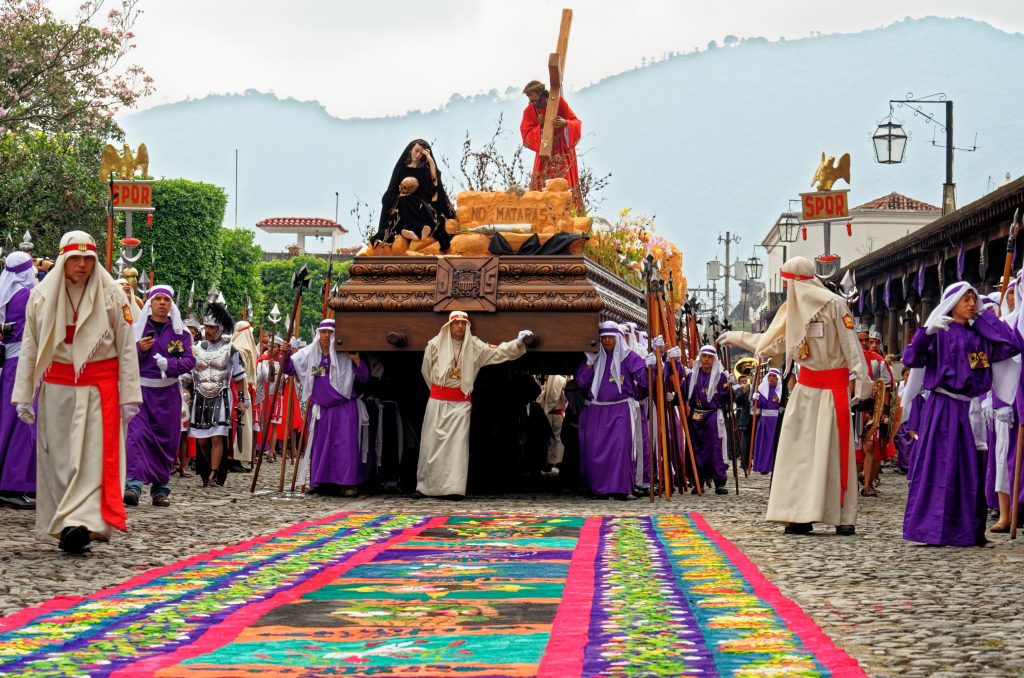
Antigua Guatemala Festivals, Celebrations And Important Dates
Whether it’s the solemnity of Holy Week, the lively hues of the Flower Festival or the buzzing excitement of the fiestas patronales Antigua’s festivals and cultural celebrations offer a glimpse into the rich tapestry of Guatemalan heritage. Here’s your guide to the most important festivals in Antigua, complete with dates and what to expect.
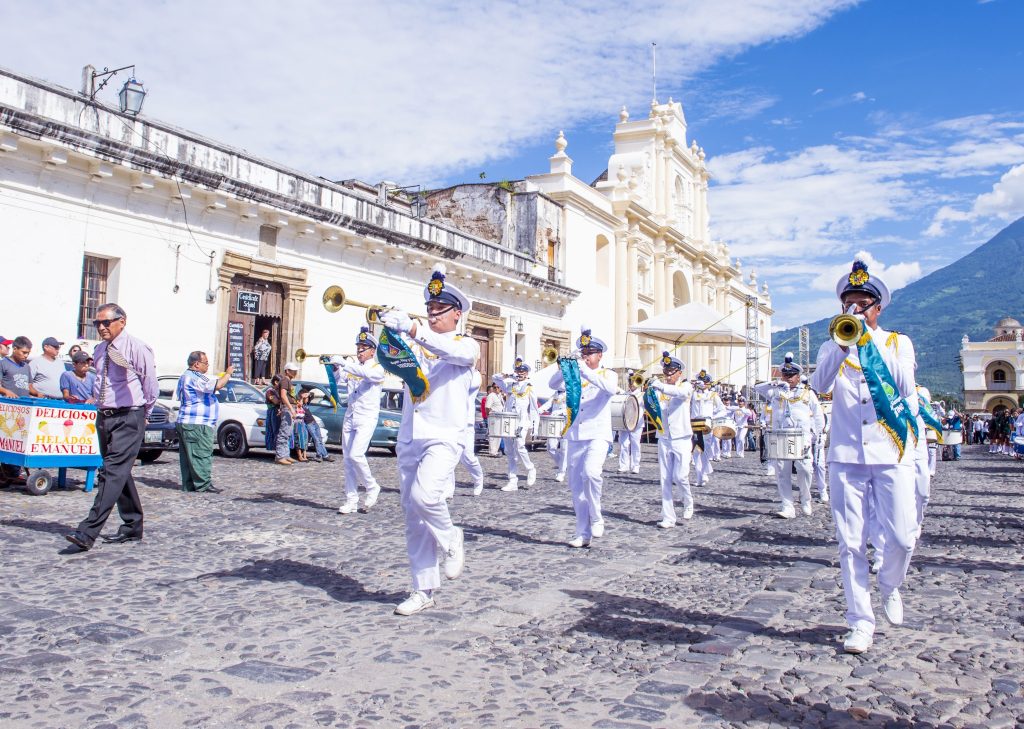
The Festival De Las Flores In Antigua Guatemala (Flower Festival In Antigua)
The Festival de las Flores, a vibrant celebration of blossoms and beauty, paints the historic streets of Antigua Guatemala in a rainbow of colors. This enchanting festival, held annually in November, is not just a feast for the eyes but a profound expression of Guatemala’s deep-rooted love for nature and cultural traditions. As the entire city transforms into a living canvas adorned with flowers, the festival brings together locals and visitors alike, uniting them in a shared experience of joy, art, and community spirit. The Festival de las Flores is more than just a celebration; it is a tribute to the eternal spring that Guatemala is so famously known for, showcasing the country’s rich floral diversity and artistic creativity. Check out my complete Guide to Visiting Antigua GuatemalaGuide to Visiting Antigua Guatemala for the best things to do in Antigua.
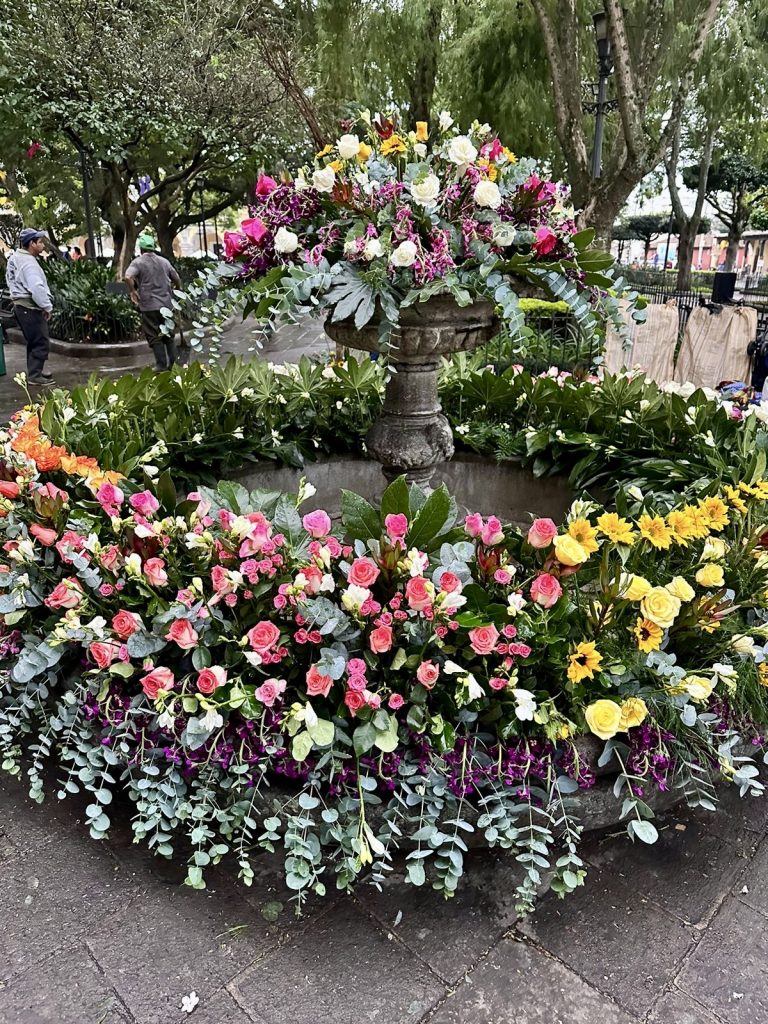
Day Of The Dead Traditions In Guatemala
Traditions for celebrating the Day of the Dead in Guatemalan include visiting loved ones that have passed, decorating altars, and eating fiambre. Small towns commemorate this important day with festivals and even horse races. One of the most important traditions on All Saints Day in Guatemala is the Guatemalan giant kite festival, where townspeople create spectacular giant kites measuring up to 15 ft.
